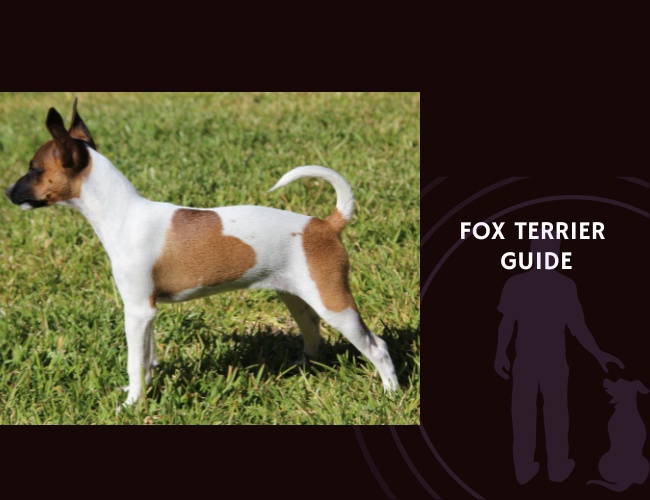Introduction to Fox Terriers
A Look Back at Their Origin
Fox Terriers have a lively past that begins in England, dating back to the late 1700s. Originally, they were bred to help with fox hunting, chasing foxes out from their dens so hunters could catch them. Their small, nimble bodies and brave attitudes made them perfect for this challenging job. Over time, people noticed their fun personalities and quick minds, making them popular beyond hunting.
Smooth vs. Wirehaired Varieties
There are two main types of Fox Terriers: the Smooth and the Wirehaired. Smooth Fox Terriers have short, flat coats that feel sleek and are easy to care for. Wirehaired Fox Terriers have a thick, rough, and sometimes curly coat, needing regular grooming to prevent tangles. While these coats look different, both types are about the same size and share many personality traits. Their behavior and energy levels do not differ much, though grooming routines will be different for each.
Defining Features and Appeal
No matter the type, Fox Terriers are best known for their keen intelligence, alertness, and boundless energy. They are small but sturdy—typically weighing around 7–8kg—and show a huge love for life. Their sharp senses and curiosity mean they are always ready for adventure and playtime. Fox Terriers tend to form strong bonds with their families and can bring endless laughter with their spirited antics. Over the years, their charm and adaptability have made them loved companions in homes all over the world.
Next, we’ll take a closer look at what makes their personalities and instinctive behaviors so unique.
Character and Behavior
Instinctive Drives and Prey Orientation
Fox Terriers have a strong instinctive drive, rooted in their genetic heritage as hunters. Their prey orientation is visible in their eagerness to chase moving objects and their quick response to small animals. Scientific studies, like genome-wide association studies (GWAS), have found that specific genes influence the intensity of this prey drive. When Fox Terriers encounter prey stimuli, their brain regions linked to reward and predation become highly active. Hormones, such as testosterone and dopamine, play a role in fueling these energetic pursuits. Controlled tests show that Fox Terriers often react quickly when exposed to moving targets, reflecting their strong predatory instincts. Early life experiences, especially exposure to prey animals, can shape how these behaviors express over time.
Social Temperament and Human Bonding Patterns
Despite their spirited energy, Fox Terriers are known for their strong social temperament. Many form deep bonds with their human companions, often showing secure attachment styles when observed in behavioral assays. The hormone oxytocin, sometimes called the “bonding hormone,” increases when Fox Terriers interact closely with their owners, promoting positive social behavior. However, this strong attachment can sometimes lead to separation anxiety. Behavioral and physiological measurements, like heart rate or cortisol levels, indicate that Fox Terriers may feel stress during extended separations, highlighting the importance of stable routines and companionship.
Reactivity to Environmental Stimuli
Fox Terriers are highly alert and responsive to their environment. They react to sounds, sights, and smells at lower thresholds than many breeds—a result of their sporting background. Studies measuring their startle responses, as well as their ability to habituate to stimuli, show that Fox Terriers can be more reactive than some other terriers. Their anxiety levels can vary, with some individuals being more sensitive to loud sounds or new places. These behaviors make regular, positive experiences in varied settings important for maintaining emotional balance.
Next, it is important to understand how best to guide and support Fox Terriers through effective training.
Training and Education
Understanding Learning Styles and Motivators
Fox Terriers thrive when training is both engaging and consistent. They respond best to operant conditioning, where desired behaviors are rewarded. Experimenting with different rewards—such as treats, toys, or praise—can help determine what motivates your particular dog. Learning curves vary among individuals, so patience is key. Some Fox Terriers may learn new cues quickly, while others benefit from shorter, repeated sessions to reinforce their memory. If a behavior begins to fade, prompt and positive reinforcement can help your Fox Terrier retain what they’ve learned over time .
Cognitive Flexibility and Problem Solving
This breed is known for sharp cognitive flexibility and excellent problem-solving skills. They enjoy activities that challenge their minds, such as puzzle toys or training games. Maze or puzzle tasks are effective tools to assess spatial learning and adaptability. Fox Terriers can shift between different tasks with relative ease. However, it’s essential to keep sessions interesting—repetitive drills can lead to boredom or stubbornness. Try varying your approach and using cognitive tests to recognize your dog’s preferred strategies.
Reliable Recall and Off-Leash Training
Recall is a critical skill, especially with a breed known for high prey drive. Building off-leash reliability requires gradual exposure to distractions and new environments. Motivation, through a combination of favorite snacks or toys, plays a major role in recall success. Environmental factors—like new scents or moving animals—can tempt a Fox Terrier to wander. Practicing recall in controlled settings before venturing outdoors helps reinforce reliable behavior. Remember that individual differences mean some Fox Terriers may take longer to master off-leash skills.
Developing a well-trained Fox Terrier is a dynamic process, where understanding their learning style and drive ensures both success and an enjoyable partnership.

Early Socialization
Critical periods for social development
The early months of a Fox Terrier’s life are the foundation for healthy social behavior. Research highlights the presence of “critical periods”–windows during puppyhood when Fox Terriers are especially open to learning about new surroundings, people, and other animals. Early socialization during this phase—usually before 14 weeks—shapes the dog’s lifelong confidence and adaptability. Puppies that miss out on safe, positive experiences during this period may grow up fearful or aggressive around the unfamiliar, making later behavioral modification much harder.
Effective socialization protocols and their impacts
Successful socialization means gently introducing your Fox Terrier puppy to a broad range of sights, sounds, people, and animals in a controlled, positive way. Good protocols might include:
- Meeting calm adults and children in different settings
- Brief, supervised playdates with vaccinated dogs
- Exposure to household noises and outdoor activity
- Short car rides and friendly visits to stores
These experiences help reduce the risk of behavioral issues, like fearfulness or territorial aggression, and support long-term emotional stability. Studies show that puppies raised with consistent, positive socialization are less likely to develop anxiety or reactivity—common concerns in high-energy breeds like the Fox Terrier.
Communication development and handler synchrony
Effective communication is about more than commands; it’s built on mutual understanding. Fox Terriers learn handler cues (voice, gestures, or facial expressions) rapidly when owners use clear and consistent signals. Activities like shared eye contact and gentle praise help puppies learn emotional cues and build synchrony with their humans. Developing this connection early not only improves training success, but also strengthens the lifelong bond between Fox Terrier and owner.
A nurturing start sets your Fox Terrier up for a vibrant, confident life—making daily adventures together even more rewarding.
Nutritional Recommendations
Energy Needs and Macronutrient Balance
Fox Terriers are lively and muscular dogs, which means their daily energy needs are higher than the average companion breed. Experts use indirect calorimetry to measure basal metabolic rate (BMR), showing meaningful differences between individual dogs based on their activity level and age. Both Smooth and Wirehaired Fox Terriers often thrive on diets balanced in protein, fat, and carbohydrates, with a focus on high-quality protein to fuel muscle and support high activity levels. Body condition scoring, a hands-on assessment of body fat, helps in adjusting food portions and controlling weight over time. It’s important to remember that even small differences in daily intake can impact such an athletic breed.
Feeding Patterns and Appetite Regulation
Many Fox Terrier owners notice that feeding schedules impact their pet’s appetite and energy levels. Research on hormones such as ghrelin and leptin shows their role in hunger and satiety. Well-timed meals, typically twice per day, help regulate body weight and avoid overeating. Monitoring food intake and weight routinely ensures that your Fox Terrier gets what they need without excess, keeping them spirited but lean.
Functional Foods and Supplements
Nutrition can also play a role in behavior and health. Certain functional foods—including diets rich in omega-3 fatty acids, zinc, and B vitamins—can promote skin and coat health while also supporting calm behaviors and emotional balance. Some studies suggest that L-tryptophan and adaptogens may help in managing anxiety and excitability. Always introduce new supplements with guidance from your veterinarian, especially since sensitivities can differ between Smooth and Wirehaired varieties.
A mindful approach to nutrition sets a strong foundation for a Fox Terrier’s well-being, supporting their physical health and vibrant temperament as they move through life.
Health Concerns and Management
Genetic markers and congenital disorders
Fox Terriers are generally robust, but some may inherit genetic conditions. Advances in genome sequencing and linkage analysis help identify mutations linked to certain congenital disorders. For Fox Terriers, specific genetic markers are being studied to predict the likelihood of hereditary diseases. Breed-specific databases can support early detection, encouraging responsible breeding and informed veterinary care. This is especially important when comparing Fox Terriers to other breeds since their unique genetic profile can reveal hidden risks.
Skin and coat health
Skin and coat care varies between Smooth and Wirehaired Fox Terriers. Both types can be prone to dermatological issues, including allergies and sensitivities. Clinical examinations and allergy testing often reveal triggers for itching or skin infections. Food sensitivities can also show up in the form of coat problems. Comparing breeds, Smooth Fox Terriers may display different allergy patterns than Wirehaired ones. Proper grooming and tailored nutrition help manage these concerns, while elimination diets may be needed if food sensitivities are present.
Neurological and seizure disorders
Some Fox Terriers may develop neurological issues, including seizure disorders. Prevalence studies, clinical assessments, and neuroimaging (such as MRI and EEG) are used to diagnose and monitor these conditions. Genetic testing can highlight inherited mutations associated with epilepsy or other brain disorders. Careful comparison between Smooth and Wirehaired varieties may reveal breed-specific vulnerabilities. If your Fox Terrier shows neurological symptoms, seeking early vet intervention is key for developing an effective management plan.
Next, we will explore how preventative routines support the overall health and vitality of Fox Terriers.
Sharp. Bold. Wired.
Hunt Born. Fox Terriers aren’t just playful—they’re purpose-built. With instincts shaped in the foxhunting fields of old England, they bring fire, focus, and fearlessness to every chase, every game, every day.
Big Drive, Little Frame.
Under 10 kilos, but unstoppable. These dogs aren’t small—they’re concentrated. Their energy, curiosity, and willpower demand structure, stimulation, and a partner who respects their spark.



Emotionally Tuned.
Beyond the bounce lies deep connection. Fox Terriers bond fast and hard, mirroring your mood, syncing to your signals. They’re not just quick on their paws—they’re quick to your heart.
Preventative Care
Vaccination protocols and immune resilience
Vaccinating your Fox Terrier is vital for long-term health and protection from preventable illnesses. Their immune resilience can vary, so veterinarians may test immune titers after vaccination to make sure your dog is well-protected. Titers check the level of antibodies, helping tailor boosters to your dog’s needs. It’s also important to follow your local veterinarian’s guidance, as some diseases are more common in certain areas. Environmental and genetic factors may impact how Fox Terriers respond to vaccines, and there can even be subtle differences between the Smooth and Wirehaired varieties regarding infection risk and vaccine response. Regular checkups help spot any changes early and keep immune health on track.
Dental and hearing health maintenance
Dental care supports a Fox Terrier’s overall well-being. Brush your dog’s teeth several times a week and provide safe dental chews to reduce plaque buildup. Professional dental cleanings, as advised by your veterinarian, can prevent gum disease and tooth loss. For hearing health, regular ear checks are especially important, as some Fox Terriers are at risk of inherited hearing loss. Brainstem auditory evoked response (BAER) testing can identify hearing deficits even in puppies, helping owners make informed care choices.
Regular health screening recommendations
Ongoing health screenings catch health issues before they become serious. Annual exams let veterinarians monitor skin, heart, neurological health, and weight. Tests for genetic disorders, especially in breeds like Fox Terriers, are a wise precaution. Early detection through screenings makes managing conditions—such as hearing loss or neurological concerns—much more effective.
By staying proactive with vaccinations, dental and hearing care, and scheduled health checks, you empower your Fox Terrier to lead a healthy, happy life. Consistent care now lays the groundwork for lifelong well-being and adds peace of mind for you as their trusted companion.
Lifestyle Considerations
Urban and Rural Adaptability
Fox Terriers can thrive in both city and countryside living, but their adaptability is strongly influenced by daily routine and owner engagement. In urban settings, it’s important to monitor and manage their stress. High noise and close quarters may lead to increased cortisol levels, indicating stress. Regular walks, outings, and mental stimulation help reduce this and provide opportunities to satisfy their curiosity and energy. In rural environments, they benefit from larger spaces and more freedom to explore. Behavioral markers like reduced barking and settled pacing often indicate better well-being in less crowded spaces. Surveys show that both Smooth and Wirehaired types can adjust well with attentive owners, though individual dogs may vary in sensitivity and adaptability.
Exercise and Physical Activity
These energetic dogs require consistent activity. Accelerometer studies show that Fox Terriers need at least 60 minutes of purposeful exercise daily. Activities such as brisk walks, play sessions, or agility games prevent boredom and decrease the risk of unwanted behaviors. Monitoring for fatigue is important, especially as dogs age. Signs of tiredness include slowed movement and increased resting between bursts of activity. Owners should adjust exercise routines depending on their dog’s age and health status.
Living with Other Pets
Fox Terriers can coexist well with other dogs and even different species if properly socialized early. Observations highlight that successful multi-pet homes rely on managed introductions and fair resource sharing. Resource-based tension and territoriality can arise, so providing separate food, toys, and spaces helps. Both Smooth and Wirehaired varieties show similar patterns, although individual temperament plays a role. With patient guidance, Fox Terriers become sociable and fun companions in diverse households.
As you continue your journey with your Fox Terrier, embracing their unique lifestyle needs is key to a healthy, happy bond.

Environmental Enrichment
Mental stimulation needs
Fox Terriers are some of the brightest, most energetic dogs you’ll meet. This breed’s strong working background means they crave mental challenges every day. Without the right stimulation, boredom can set in quickly, leading to unwanted behaviors such as digging, excessive barking, or destructive chewing. Daily brain teasers—like puzzle toys and scent work—help keep them happy. Enrichment is more than entertainment; it supports their cognitive function and wellbeing by letting them problem-solve and explore in safe, productive ways.
Effective enrichment protocols
Providing variety is key to successful enrichment. Interactive toys, such as food-dispensing puzzles or treat balls, transform mealtime into a game. Scent games and basic agility courses also tap into their natural hunting instincts. Short, frequent sessions (ten to fifteen minutes, a few times per day) work best, keeping enthusiasm high without overwhelming them. Remember, both Smooth and Wirehaired Fox Terriers show individual preferences, so it’s smart to try different activities and see what your dog enjoys most. Enrichment plans should adapt as the dog ages to support ongoing engagement and growth.
Impact on behavioral problems
There’s a proven link between mental stimulation and reduced behavioral issues in Fox Terriers. Dogs with daily enrichment are less likely to display anxiety or aggression, especially in unfamiliar settings. When a dog’s brain is busy, they’re less likely to react strongly to stressful stimuli or develop problem habits. Enrichment also helps in building confidence, especially for dogs who may be fearful around new experiences.
Breed-specific activities and toys
Fox Terriers love toys that mimic prey, like tug ropes and balls, encouraging their chasing and hunting skills. Puzzle feeders and scent games challenge their sharp minds. Agility tunnels, ramps, or hurdle jumps make great use of their boundless energy and quick reflexes. Rotate activities weekly to keep things fresh and engaging.
With their minds and bodies engaged, Fox Terriers thrive as balanced, happy companions, ready to enjoy life both at home and in the wider world.
Living with a Fox Terrier
Building Emotional Connection
Fox Terriers thrive on close bonds with their families. Studies show that these dogs often mirror the emotions and stress levels of their owners, a phenomenon known as emotional contagion. For instance, if you come home anxious or stressed, your Fox Terrier may pick up on those cues, becoming more restless or reactive. This remarkable emotional synchrony means that your mood and routines can deeply influence your dog’s behavior. Fostering calm, predictable interactions helps your Fox Terrier feel secure and strengthens your relationship.
Navigating High Energy Levels
Managing a Fox Terrier’s energy starts with understanding their needs. Regular, structured activities—daily walks, play sessions, and training games—are essential. Fox Terriers are happiest when their bodies and minds are challenged. Without enough stimulation, they may develop unwanted behaviors like digging or barking. Activities like puzzle toys, scent work, or agility not only burn off energy but also provide mental engagement, reducing stress and boredom.
Adapting to Age-Related Changes
As your Fox Terrier grows older, you might notice shifts in activity and stamina. Puppies and adults often demand intense play, but seniors may show signs of fatigue sooner. Adjust exercise routines to match energy levels, watch for changes in mobility, and introduce gentler enrichment activities as needed. Tailoring care based on age supports your dog’s comfort and happiness throughout life.
Continual understanding and support help your Fox Terrier integrate into your life with joy and companionship.
Choosing the Right Fox Terrier
Understanding Smooth vs Wirehaired Beyond Appearance
Choosing the best companion begins with knowing the distinctions between Smooth and Wirehaired Fox Terriers that go deeper than coat texture. While both share high energy levels, intelligence, and hunting instincts, there are subtle differences in behavior and how they express emotion. Research shows that each type may respond differently to enrichment, social cues, and even lifestyle routines—with Wirehaired Fox Terriers sometimes showing a greater need for complex enrichment and stronger bonds in emotional synchrony with their humans .
Assessing Temperament in Puppies and Adults
Temperament is key when bringing a new Fox Terrier into your life. Take your time to meet the dog in different settings and observe its reactions to noise, strangers, and novel situations. Smooth Fox Terriers may display quicker response times to training cues and can be slightly more independent, while Wirehaired types often excel at reading human emotional states, leading to more co-regulated behavior. It’s also useful to ask about early socialization, as this impacts future behavior and adaptation.
Aligning Traits with Your Lifestyle
Before making your choice, reflect honestly on your routine and energy level. Fox Terriers are best suited for homes where regular exercise, mental stimulation, and interaction are a daily norm. Smooth varieties might adapt better to busy, urban living with slightly less need for constant enrichment, whereas Wirehaired types thrive in dynamic or emotionally connected households. If you have other pets, observe social compatibility—not all Fox Terriers are equally suited to multi-species homes.
Fox Terriers offer a rich, active companionship, but their happiness depends on the fit with your lifestyle. A little planning now sets the stage for years of joyful partnership.
Conclusion
Key Considerations for Owners
Living with a Fox Terrier offers joy, but success depends on truly understanding their character and needs. These energetic dogs need more than basic care; they thrive on daily exercise, consistent training, and plenty of mental stimulation. Early socialization is essential to help them become confident and friendly with other animals and people. Routine preventive care, including dental checks and vaccinations, ensures long-term health.
Both Smooth and Wirehaired Fox Terriers have distinct coat and grooming needs. Smooth coats are lower maintenance, while Wirehaired coats benefit from regular hand-stripping. Health screening for genetic or breed-related conditions, such as hearing checks and skin health evaluations, supports lifelong well-being.
Ongoing Education and Support
As a Fox Terrier owner, connect with breed-specific clubs and online communities for support and fresh ideas. Regularly consult your veterinarian for up-to-date advice on nutrition and preventive health. Investigate canine enrichment resources, including puzzle toys or local agility classes, to keep your Fox Terrier’s mind active. Reading current research and guides helps you stay informed about best practices for care and behavior management.
The Unique Rewards
Sharing your life with a Fox Terrier means welcoming enthusiasm, intelligence, and playful energy into your home. These loyal companions form deep emotional bonds, bring laughter with their antics, and stay engaged in daily family life. With patience and commitment, Fox Terriers reward you with a relationship built on trust, fun, and unwavering companionship.










